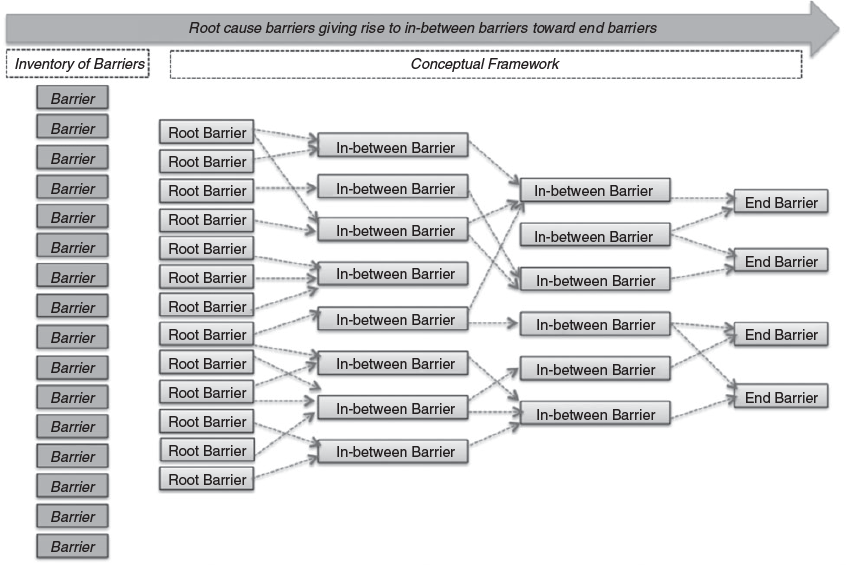Primary care access barriers faced by immigrant populations in their host countries: a systematic review protocol aiming to construct a conceptual framework using root cause analysis to capture ‘what leads to what’
Tanvir C. Turin 1 2 6 , Nashit Chowdhury 1 , Mahzabin Ferdous 1 , Ruksana Rashid 1 , Marcus Vaska 3 , Nahid Rumana 4 , Nafiza Rahman 5 , Mohammad Lasker 5 , Mohammad Z. Chowdhury 1 21 Department of Family Medicine, Cumming School of Medicine, University of Calgary, 3330 Hospital Drive NW, Calgary, AB, T2N 4N1, Canada
2 Department of Community Health Sciences, University of Calgary, 3280 Hospital Drive NW, Calgary, AB, T2N 4Z6, Canada
3 Knowledge Resource Service, Tom Baker Cancer Centre, Alberta Health Services, 1331 - 29 Street NW, Calgary, AB, T2N 4N2, Canada
4 Sleep Center, Foothills Medical Centre, University of Calgary, 1403 - 29 St NW, Calgary, AB, T2N 2TN, Canada
5 Community-based citizen researcher, Calgary, AB, Canada
6 Corresponding author. Email: chowdhut@ucalgary.ca
Journal of Primary Health Care 12(2) 139-148 https://doi.org/10.1071/HC20006
Published: 11 May 2020
Journal Compilation © Royal New Zealand College of General Practitioners 2020 This is an open access article licensed under a Creative Commons Attribution-NonCommercial-NoDerivatives 4.0 International License
Abstract
INTRODUCTION: Understanding primary care access or health service utilisation challenges among immigrant communities is important for tailoring services to community needs, which is the core of precision population health.
AIM: We aim to inventory the primary care access barriers faced by immigrant communities through a comprehensive systematic review and develop a conceptual framework to explain the barriers, using a root cause analysis approach.
METHODS: Academic databases of primary research articles and grey literature will be searched using appropriate keywords. Relevant information will be extracted into tabular format from finally selected literature. Our proposed approach of framing the barriers to identify the root causes is adapted from the root cause analysis method, which is the process of identifying and understanding the underlying causes to discover the root causes of problems.
RESULTS: The study will produce a systematic, quantified and documented list of the barriers faced by immigrants in a solution-oriented approach.
DISCUSSION: The proposed research, as a first step towards determining possible mitigation strategies for health-care access by immigrants, will provide the background needed to devise and test tailored interventions to improve future access to health care for immigrants. We will follow the integrated knowledge translation or community engagement knowledge mobilization approach, where we are engaged with community-based citizen researchers from the inception of our programme. We plan to disseminate the results of our review through meetings with key stakeholders and social media outreach, followed by journal publications and presentations on relevant platforms.
KEYwords: Primary care; immigrants; barriers; solutions; root causes
| WHAT GAPS THIS FILLS |
| What is already known: A number of barriers has already been identified regarding the immigrants’ access to primary health care. |
| What this study adds: Capturing the complexity and breadth of access barriers, this study will inform the development of a conceptual framework which looks at the barriers through solution-oriented lens. |
Introduction
International migration, which is common all over the world, is the movement of people from one country to another with the intent to settle.1 This has resulted in the formation of multicultural communities where immigrants from various ethno-geographical backgrounds exhibit differences in their culture and practices of life. Their diseases and disease predispositions vary widely due to sociodemographic aspects of their country of origin, and their ethnic predisposition, economic circumstances, preferences and ways of living. Researchers have reported several factors affecting immigrants’ health and wellness adversely in their new environment. These include challenges in acculturation or adopting a new lifestyle,2 environmental factors,3 post-migration stress4 and discrimination.5 Eventually, these factors create barriers to immigrants accessing health care in the host countries.
Understanding primary care access or health service utilisation challenges among immigrant communities is important for tailoring services to community needs, which is the core of precision population health. A cross-sectional approach, using frameworks like Anderson’s health service utilisation model,6,7 the healthcare access barrier model8,9 or a social ecological model,10,11 commonly has been used to explain disparities in immigrant health-care access. However, the theoretical frameworks designed to account for access barriers remain underdeveloped in terms of capturing the sequence of elements leading to those barriers. The concept that some barriers that occur in the earlier phases of access contribute to barriers in the later phases has not yet been fully realised. This reformulation or reconceptualization should be fully informed by the causal mechanisms through which the cascade of barriers occurs. This approach could help advance innovative solutions or interventions around barriers that occur in the early phases, more appropriately termed ‘root causes’.
Additionally, the perspectives of immigrant communities on possible solution-oriented approaches also need to be captured. This perspective is very important, as immigrant patients bring their unique experience and knowledge gained through living with the problems they face. Unfortunately, meaningful active involvement of the immigrant community in conducting research, governance, priority setting and knowledge translation or mobilization has not occurred. Through our programme of research, we aim to shape solution-centred implementation research based on priorities identified by the immigrant community for further pursual by all study team members collectively, but particularly with members of the immigrant community.
In this proposed study, we aim to inventory the barriers faced by immigrant communities while accessing primary care in their host countries through a comprehensive systematic review, and develop a conceptual framework explaining the barriers through a root cause analysis approach, with meaningful collaborative engagement with academics; practice and policy advisors; and immigrant grassroots community members.
Methods
We propose two steps to achieve our objective: a systematic literature review and framework development (Fig. 1). A detailed logic map of the process is presented in Table 1.
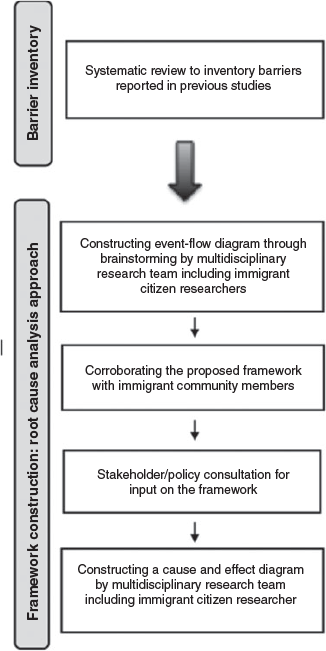
|
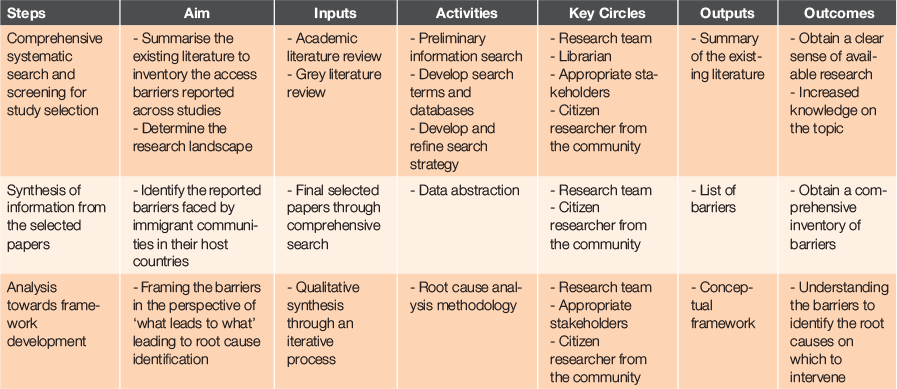
|
Systematic review
We will use the core steps of conducting a systematic review to capture the available literature on barriers faced by immigrant communities while accessing primary care (Fig. 2). This will allow us to systematically chart the available literature on the topic. Table 2 details the search terms, databases searched, and inclusion criteria.
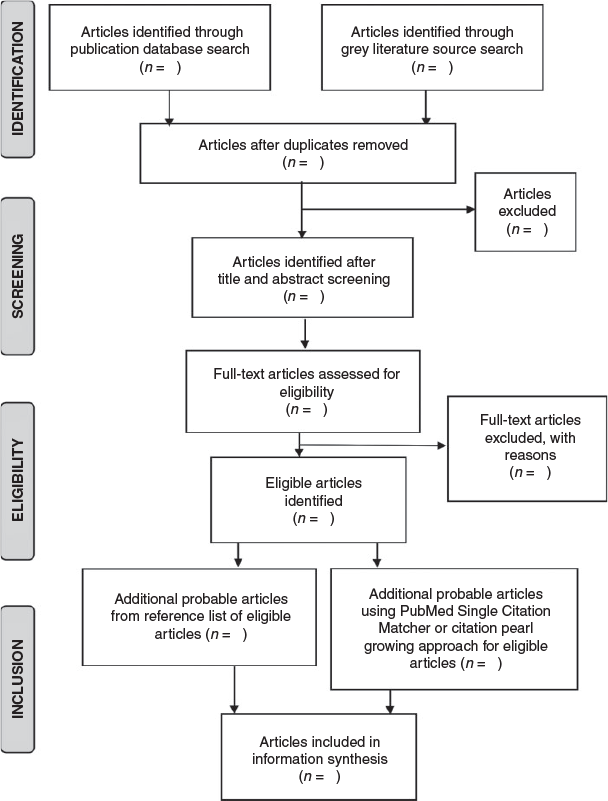
|
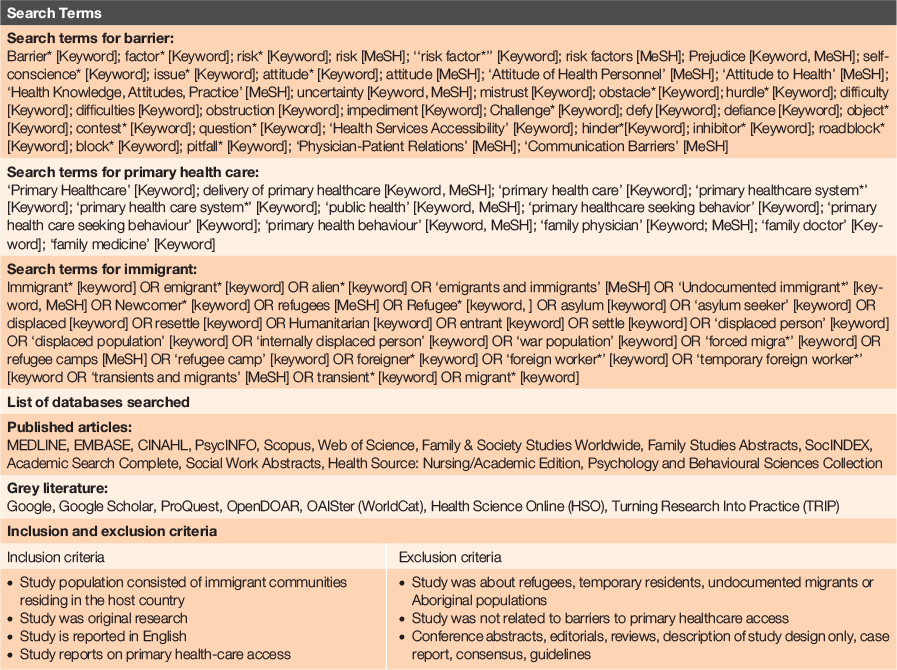
|
Inclusion and exclusion criteria
This study will include all journal articles; dissertations and theses; and the grey literature on barriers to accessing primary care. There will be no restriction on study design, country of origin or publication date in selecting studies. However, studies will be limited to those written in English only.
Comprehensive systematic search
We will systematically search12 different indexed and non-indexed databases, repositories and online portals (Table 2) according to a predefined search strategy. We have an experienced librarian (M. Vaska) on our research team who will oversee how the search strategy is developed and how the search is conducted. The search will be based on a carefully selected list of keywords and medical subject heading (MeSH) terms (Table 2). Our search strategy adheres to the Cochrane Collaboration approach to systematic searching, where the controlled vocabulary (MeSH terms) is combined with keyword searching.13 To maintain a comprehensive search of the topic, we will search the reference lists of the selected studies manually to identify additional related articles. This will ensure that we capture all relevant studies that may have been missed in the automated electronic database search. Additionally, single citation searches and the pearl-growing approach will be performed in PubMed and Google Scholar on all finally selected publications. A grey literature search will include electronic institutional repositories, Canadian national and provincial organizations, international professional and government websites, Google and Google Scholar. Unpublished dissertations and theses will be searched using the ProQuest Dissertations and Theses database. Further, information about in-progress and ongoing research projects will be gathered from Health Services Research Projects in Progress (HSRProj).
Study selection process
Initial search results will be imported into EndNote for duplicate removal. We will perform a two-stage screening following the specified inclusion and exclusion criteria (Table 2). Initially, two researchers will independently review and screen the title and abstract of each article for inclusion in the study. Later, full-texts of articles meeting the study’s eligibility criteria will be examined and reviewed further for relevance. This stage of screening (full-text screening) will be also be performed independently by two reviewers, and any disagreements will be resolved through consensus and consultation with a third reviewer.
Data extraction
Predefined information will be extracted from the finally selected studies. Two trained team members of our research group will be involved in data extraction. The first member will extract the information using a predetermined abstraction tool, while the second member will check the completeness and accuracy of abstraction. Extracted information will include the citation, study location, study objective, study population, study design, data collection method used and the barrier description (Table 3). Data extraction will be performed independently and the database will be built in Microsoft Excel (Microsoft Corporation, Redmond, Washington, USA).
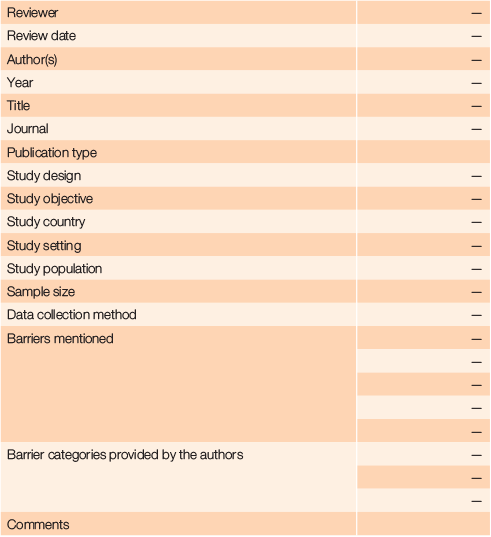
|
Framework construction: root cause analysis approach
Our approach of framing the barriers to inform root cause identification is adapted from the root cause analysis (RCA) method, which is the process of discovering the root causes of problems to identify appropriate solutions.14,15 RCA assumes that it is much more effective to systematically prevent and solve underlying issues than simply treat ad hoc symptoms and ‘put out fires’. We will use it to devise interventions to mitigate or eliminate the cause and prevent the problem from recurring. RCA involves applying a series of well-known, common-sense techniques that can produce a systematic, quantified and documented approach to identify and understand underlying causes.16,17 We will use the RCA approach to frame the identified barriers in a solution-oriented way. We will conduct a gender-stratified analysis also, as the issues faced by men and women are different, particularly among immigrants. Citizen researchers, our community collaborators, have been engaged in our project planning and will be active in the overall process.
Constructing an event-flow diagram through brainstorming by the multidisciplinary research team
An event flow diagram is a chronological diagram of the ‘what leads to what’, leading up to a final event; in this case, exposing the factors that cause the health-care barriers (Fig. 3). Currently, most processes followed are mapped out in a flowchart. Flowcharts graphically organise information about a process, making clear what is affected. When a problem has a documented process, this can be a useful tool to help understand what is occurring. In this study, the event flow diagram will provide a visual tool to help understand how a specific access issue is developed and becomes a barrier to health-care access. At each step of the diagram, questions will be identified to help the RCA team better understand why each step of the barrier process has occurred. We will also incorporate, in our analysis, the differences in entitlements across different subgroups of the immigrant populations and the effect these have on the access issues. Further, we will construct gender-specific event flow diagrams, as cultural differences between men and women have been reported to be an important determinant in health-care approaches. We anticipate that multiple study meetings on a bi-weekly basis will be required to develop the flow diagram.
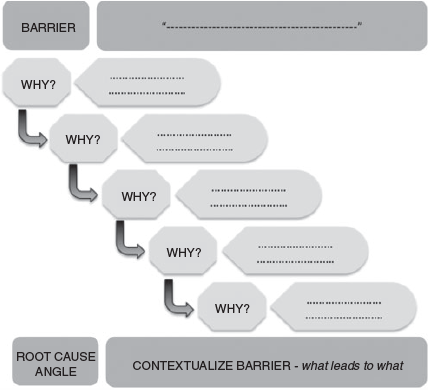
|
Corroborating the proposed framework with immigrant community grassroots members
This step of our research will involve holding consultation sessions with immigrant community members to discuss the event flow diagram being developed to frame the barriers. This will allow participants, including our research team citizen researchers, to provide feedback on the framing. They will be pivotal in contextualizing the data generated from the systematic review phase and will be able to contribute to generating deep insight about the possible solutions.
Consulting with relevant stakeholders
The third step of our research will involve holding consultation sessions with various primary care stakeholders identified at the phase of constructing the event flow diagram. We will share the flow diagram and the comments gained from the immigrant grassroots community members with the stakeholders to obtain their input on framing the barriers. This input can be used to generate deep insight into how the participants feel about the solutions, and will help to make the results readily digestible by local decision-makers.
Constructing a cause-and-effect diagram to determine root causes
Based on the consultation feedback, we will develop a cause-and-effect diagram to identify the causal links between the root cause(s) and the factors contributing to the specific endpoint barriers (Fig. 4). Using the access to health-care issue as an endpoint, the question ‘why’ will be asked repeatedly until we can devise the barrier’s root cause. Factors that may contribute to this root cause will also be noted. Our citizen researcher and policy team members will play an important role in this phase to guide our research team.
At the final stage of the analysis, we will use thematic analysis14,18 to identify overarching issues and themes arising from the RCA. The thematic analysis will be conducted by comparing the root cause statements and recommendations generated from the community consultations. The barriers will be reviewed and root causes will be allocated under appropriate causal categories. Final disposition of any differences among investigators will be reached by consensus.
Ethics approval
We expect to publish the results of the systematic review and conceptual framework development in academic and non-academic outlets. For the systematic review component, we will not need ethics approval. For the community feedback through engagements and stakeholder consultations, we will seek ethics approval from the institutional ethics board.
Knowledge engagement
We have already engaged the potential end users of our research in this research process and dissemination and implementation plans (Table 1). We will employ the core philosophy and tools of integrated knowledge translation19 or community-based participatory research.20 We plan to disseminate our research findings to the community and relevant stakeholders by creating suitable info-graphics, pamphlets and posters, with the help and guidance of the team’s citizen researcher members. Our research findings will be disseminated in lay languages targeting community members through platforms such as social media, ethnic language newspapers and ethnic online news portals. In addition, knowledge translation materials will be distributed during different social and cultural events. We will continue the engagement initiatives during every step of the project to maintain constant involvement with the community. We believe this will inform future directions and help identify an improved procedure for more focused and effective community-engaged research initiatives. We will also use conventional academic channels, such as conference abstracts, manuscripts and policy briefs, to propagate our work.
Discussion
Anticipated outcomes
The current global geopolitical situation is driving immigration towards developed Western countries. Therefore, the proposed research, as a first step towards determining possible mitigation strategies for health-care access by immigrants, is essential. Importantly, this research will not only provide connection and capacity-building opportunities, but also will provide the background needed to devise and test tailored interventions to improve future access to health care for immigrants. It will establish a knowledge base that describes barriers and facilitators commonly encountered by immigrants in accessing health care and identify evidence-based intervention strategies to overcome barriers. It will specifically detail those barriers, facilitators and interventions through the lens of the immigrant community itself.
Several specific objectives will be achieved through this review, including being able to inventory the different reported access barriers across different studies. We also will be able to capture the different frameworks and models used by researchers to explain their findings. This review will also assist in developing a framework that considers a ‘what leads to what’ sequence while framing the barriers. The research question and the purpose for gathering information are clearly identified in the Introduction section of this protocol. The Methods section documents the study selection procedures and presents the steps required to gather, code and aggregate the findings from the individual studies. The inclusion criteria outlined in the protocol is applicable regardless of the type of study. By taking into account all of the different study types (e.g. quantitative, qualitative and mixed-methods) in our review, we plan to deliver an in-depth review and make recommendations that are applicable to stakeholders. The findings from this review will significantly contribute to generating knowledge to inform and guide practice and policy. We believe our framework will contribute to approaching solutions in a more coherent manner.
Strengths and limitations
The strengths of this review are the comprehensiveness of the search process and the application of rigorous methodology to answer the research questions. The proposed meaningful community engagement approach will benefit the study by maximizing knowledge engagement and mobilization at different community levels and across academia, policymakers and service providers. An experienced research team that includes, among others, a librarian (M. Vaska) with extensive experience in conducting comprehensive systematic, grey and web searches, is undertaking the proposed study. In addition to crafting the search strategy, the librarian also helped frame a data extraction template and provided a flexible approach to data acquisition. Citizen researchers and community champions are also part of our research group, and they have been involved from the beginning, the brainstorming phase of our study, which is another key strength. Nevertheless, this study also has limitations. Excluding non-English studies may fail to capture some important knowledge mobilization activities not published in English. In addition, care must be taken to ensure the best evidence is identified in solving the research queries, as community-based research is complex and involves different levels of activities. We also chose not to conduct a quality assessment of the selected papers, as our study team agreed that a more inclusive approach to our selection of papers is important for our study purpose. In fact, for this study, we are conducting the systematic review as a data-collection tool to make an inventory of the barriers that have been reported across studies. Treating what we find as raw data, we will undertake the root cause analysis for developing the conceptual framework. Despite having some limitations, our proposed study will establish a practical base for developing a strategic approach towards developing a framework that explains the identified barriers in a solution-oriented way.
Competing interests
The authors declare no competing interests.
Funding
This research did not receive any specific funding.
References
[1] Castles S. International migration at the beginning of the twenty-first century: global trends and issues. Int Soc Sci J. 2000; 52 269–81.| International migration at the beginning of the twenty-first century: global trends and issues.Crossref | GoogleScholarGoogle Scholar |
[2] Hyman I. Immigration and health. Health Policy Working Paper Series. Working Paper 01–05. Ottawa: Health Canada; 2001.
[3] Carter T, Polevychok C, Friesen A, Osborne J. The housing circumstances of recently arrived refugees: the Winnipeg experience. Edmonton: Prairie Metropolis Centre; 2008.
[4] Miedema B, Hamilton R, Easley J. Climbing the walls: structural barriers to accessing primary care for refugee newcomers in Canada. Can Fam Physician. 2008; 54 335–6.
| 18337519PubMed |
[5] Williams DR, Mohammed SA. Discrimination and racial disparities in health: evidence and needed research. J Behav Med. 2009; 32 20–47.
| Discrimination and racial disparities in health: evidence and needed research.Crossref | GoogleScholarGoogle Scholar | 19030981PubMed |
[6] Derose KP, Bahney BW, Lurie N, Escarce JJ. Immigrants and health care access, quality, and cost. Med Care Res Rev. 2009; 66 355–408.
| Immigrants and health care access, quality, and cost.Crossref | GoogleScholarGoogle Scholar | 19179539PubMed |
[7] Pandey SK, Cantor JC, Lloyd K. Immigrant health care access and the affordable care act. Public Adm Rev. 2014; 74 749–59.
| Immigrant health care access and the affordable care act.Crossref | GoogleScholarGoogle Scholar |
[8] Carrillo JE, Carrillo VA, Perez HR, et al. Defining and targeting health care access barriers. J Health Care Poor Underserved. 2011; 22 562–75.
| Defining and targeting health care access barriers.Crossref | GoogleScholarGoogle Scholar | 21551934PubMed |
[9] Pierre-Louis RE. Exploring direct and indirect effects of English proficiency on access, utilization, and health status among Californian adults with limited English proficiency (LEP) [dissertation]. South Orange, New Jersey: Seton Hall University; 2018.
[10] Gele AA, Qureshi SA, Kour P, et al. Barriers and facilitators to cervical cancer screening among Pakistani and Somali immigrant women in Oslo: a qualitative study. Int J Women’s Health 2017; 9 487–96.
| Barriers and facilitators to cervical cancer screening among Pakistani and Somali immigrant women in Oslo: a qualitative study.Crossref | GoogleScholarGoogle Scholar |
[11] Nguyen-Truong CK, Lee-Lin F, Leo MC, et al. A community-based participatory research approach to understanding pap testing adherence among Vietnamese American immigrants. J Obstet Gynecol Neonatal Nurs. 2012; 41 E26–40.
| A community-based participatory research approach to understanding pap testing adherence among Vietnamese American immigrants.Crossref | GoogleScholarGoogle Scholar | 23030739PubMed |
[12] Ahmed S, Vaska M, Turin TC. Comprehensive systematic search process of health literature: hunting pearls out of the sea. J Nat Heart Foundation Bangladesh. 2016; 5 12–16.
[13] King’s College London. Library guides. Searching for systematic reviews: advanced search techniques. London: Kings College; 2020. [cited 2019 September 26]. Available from: https://libguides.Kcl.Ac.Uk/systematicreview/advanced
[14] Reed RL, Isherwood L, Ben-Tovim D. Why do older people with multi-morbidity experience unplanned hospital admissions from the community: a root cause analysis. BMC Health Serv Res. 2015; 15 525
| Why do older people with multi-morbidity experience unplanned hospital admissions from the community: a root cause analysis.Crossref | GoogleScholarGoogle Scholar |
[15] Tableau. Root cause analysis, explained with examples and methods. Seattle, WA: Tableau Software, LLC; 2020. [cited 2019 August 1]. Available from: https://www.tableau.com/learn/articles/root-cause-analysis
[16] Vorley G. Mini Guide to Root Cause Analysis. London, UK: Quality Management & Training (Publications) Ltd.; 2008.
[17] New South Wales Department of Health. Checklist flip chart for root cause analysis teams. North Sydney, NSW: NSW Department of Health; 2004. [cited 2019 August 1]. Available from: http://www.cec.health.nsw.gov.au/__data/assets/pdf_file/0007/313297/Checklist-Flip-Chart-for-Root-Cause-Analysis-Teams.pdf
[18] Braun V, Clarke V. Using thematic analysis in psychology. Qual Res Psychol. 2006; 3 77–101.
| Using thematic analysis in psychology.Crossref | GoogleScholarGoogle Scholar |
[19] Canadian Institutes of Health Research. Guide to knowledge translation planning at CIHR: integrated and end-of-grant approaches. Ottawa, Ontario: Canadian Institutes of Health Research; 2015. [cited 2019 October 2]. Available from: https://cihr-irsc.gc.ca/e/documents/kt_lm_ktplan-en.pdf
[20] Social Sciences and Humanities Research Council. Guidelines for effective knowledge mobilization. Ottawa, ON, Canada: Social Sciences and Humanities Research Council; 2019. [cited 2019 October 2]. Available from: https://www.sshrc-crsh.gc.ca/funding-financement/policies-politiques/knowledge_mobilisation-mobilisation_des_connaissances-eng.aspx


